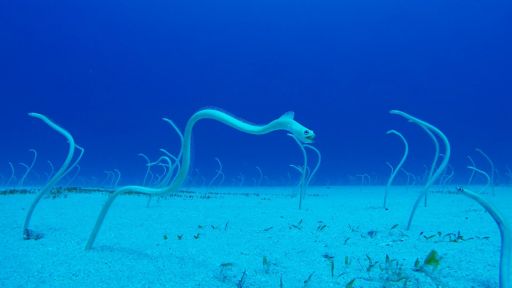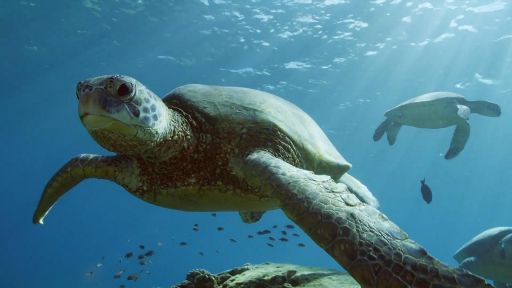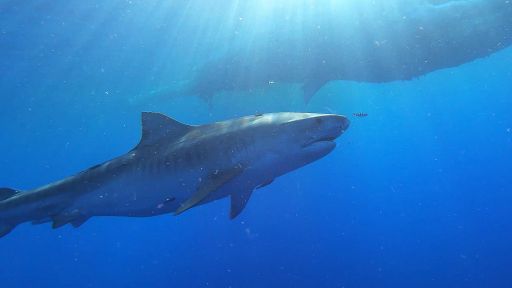As with any PBS NATURE film, the key to getting the shots is time spent out in the field. Fortunately, for the crew of “Sharks of Hawaii” that meant the tropical islands of Hawaii.
Features




- As with any PBS nature film, the key to getting the shots is time spent out in the field.
Fortunately for the crew on this film, that meant Hawaii.
My name is Kevin Bachar, producer of the film, 'The Sharks of Hawai'i.'
I'd be working with cinematographer Paul Atkins where the shores of Maui would be our spectacular office for the next week.
(splashing) - Ready? Coming right at us.
(water burbling) - I'm Paul Atkins and I'm here in Maui filming humpback whale interactions with tiger sharks.
It takes a lot of planning and research and months of filming to bring the natural world to your living room.
(water gurgling) (whale blows) - Conditions are like absolutely perfect for underwater.
And according to my app they're, the wind's going to come up this afternoon.
So I'd love to get another shot at a mom and calf.
- Paul was here to capture the return of the humpback whales to Hawaii and how tiger sharks impact their arrival.
- We're on a resting pair, a mother and a calf here right outside the Harbor.
And we've been really lucky with them so far, getting shots of different behavior, while we're on snorkel.
But now I'm going to try to get underneath with a pony bottle and breathe scuba.
And some mothers don't like scuba bubbles and some allow it.
So it's a little bit tricky, but it allows us to get down actually with them at their level.
- Helping guide the film crew was Dr. Adam Pack who has been researching the whales for over 20 years.
Dr. Pack studies mother and calf relationships.
His special camera allows him to get precise sizes for the whales.
- Mom is very calm, allowing me to take sizes on her using videogrammetry.
- And then calf surfaced, was very curious came right over, turned ventral side towards us.
I could see the hemispherical lobe just coddle to the genital slit which indicates it's a female, only females have that lobe.
It's about the size of a baseball on a calf and about the size of a grapefruit on a mom.
And the calf just continued milling.
When it ducked below the surface and straightened out I was able to get a size of the calf.
Typically calves are about 10 to 12 feet long when they're born.
In contrast mom is about 45 feet long with a huge girth, which allows her to store a lot of fat.
It's important to get these data because we're interested in the size of the moms and the size of their calves that they produce.
It seems that healthier, bigger moms produce larger, healthier calves.
And that's important for calf survival.
We know that calf mortality is between 18 and 20% in the Hawaii-distinct population segment.
And that's based on old data.
So we're trying to collect new data to see if those parameters have changed.
- The crew set up shop on a small boat.
They would approach the whales at a safe distance to capture footage.
(water gurgling, soft music, and whale song) The humpbacks travel over 3000 miles from Alaska.
Once here, it's a chance for mother and calf to bond.
The calf's world is defined by its mother: where she goes, the calf follows.
- I've been doing this for about 25 years out in these waters and all, also off the Big Island.
And that's one of the best encounters I've ever had with a humpback whale.
This was a female juvenile humpback whale, extraordinarily friendly, not only with the boat, but with the divers as well.
I went in to get body sizes so that we can learn the relationship between size and behavior of the animals, and all that science is great, but this female was, was friendly.
It was respectful of us and was curious.
And I have to say you can look right into this whale's eye.
She was just taking it all in.
She was, she almost seemed excited to see us and curious about us in the same way that we are curious about her.
It's really special when that occurs.
- Wow. Well we have the friendliest female humpback I've ever seen in my life.
My God, we're just swimming with her at the surface and she's coming up and she's coming up fluke-first, and the flukes are coming out of the water.
And she's coming over and playing with us, and we're just able to get these incredible closeup shots.
She's so considerate.
She's, with these flukes, she could like knock us out.
But instead, they come like inches from your face and the camera and then they just stop, just before you're touching it.
Then this mass of bubbles and everything.
It's just amazing, really.
It was an amazing, amazing encounter.
(laughs) - In addition to the mother and calf pairings we also filmed single males.
They're here to find a mate.
(waster whooshing) One of the highlights was coming upon singing whales, only males croon.
It's not exactly known why they break out into song.
It could be a way to attract females or warn other males they're in his territory.
Paul was able to approach one of these singers.
(water gurgling) - To find a whale like this, an individual like this: it's a goldmine, you know, for research and photography.
- The escort seemed that he was being challenged by some challengers.
And we were getting a little head lunging and some surface action.
That's what we were looking for.
- For Dr. Pack, one of his goals on the shoot was to capture a biopsy from a whale.
This data would help determine the health of the pods and help alert them to any environmental factors that may be impacting the whales.
- It's always exciting to be able to get this information.
It's going to tell us a lot about not only her, but about this population in general and how it's doing.
- He'd be using a rather old fashioned method to capture his biopsy: a crossbow.
The dart would only enter the first half-inch of whale blubber.
- Now I'm going to use this to obtain a small piece of skin and blubber from the whale, we call that a biopsy sample.
The piece is about the size of an eraser but it can provide us with a lot of information, and sex if we need that.
We can also learn about the whale's genetics this way.
So there's a lot of information that we can get, very important information, from this sample.
- No more than a pinprick on a 40-ton, 40-foot creature.
- Come on, Mom.
(whale blows) - No, you're good.
I've got to, she's gotta be a little higher.
- It wouldn't be an easy task a small boat, four-foot swells, and a fast moving whale.
- Okay.
(dart snaps) - Like that.
- Robin Hood himself would be jealous.
- That was good.
That was a perfect shot.
Mom was nice and calm.
We're going to want to wait for that high arch.
So we have a nice target area for her.
And we were able to get, you know, perfectly that biopsy sample of skin and blubber.
So we can understand her progesterone level whether she's ovulating, whether she is already pregnant with another calf, perhaps, it's going to tell us a lot about not only her, but about this population in general and how it's doing.
(whale blows) - Another key component in studying the whales and filming them was the use of a drone.
The Pacific Whale Research Center uses the aerial view to gather size data on the whales.
It can be dangerous.
High wind and a heavy swell made launching the drone risky.
The researchers used caution.
(drone buzzes) Safety prevailed.
And the view they captured was spectacular.
- I am collecting data to go with the drone footage we're collecting.
So I'm recording how many animals are in this group, and the time-stamp for each of these measurements.
So we can sync it up to the ID photos that Adam's taking.
- The tiger sharks were known to be in the area but filming an attack eluded the crew for a number of days.
- We do on occasions, you have tiger shark interactions with humpback whales that we do observe.
Typically it's not on healthy individuals, but it's on sickly individuals, especially if a calf is separated from its mom, tiger sharks start showing up.
And it's just a matter of time before they make a kill.
- But there was evidence of their presence: a young calf bore the marks of an encounter.
Paul was able to get footage of the scar.
(water gurgling) Fortunately, it seemed to have no effect on the young calf.
- You can't help when you have something like this but be humbled by these whales.
They are majestic creatures.
And when you see them underwater, they're so fluid not bulky or anything.
They're fluid like dancers in space.
And it's just, it takes your breath away.
- By capturing a three-level look at the whales from the air, the surface, and below, Paul and the crew were able to bring back the type of film and storytelling that not only informs but inspires.
